As a pet owner, it is natural to feel anxious when your dog is scheduled for surgery. You want to ensure that everything goes smoothly and that your furry friend is safe throughout the process. One concern that may arise is if your dog accidentally drinks water before surgery. In this article, we will explore this topic and provide you with the necessary information to ease your worries.
It is common for veterinary hospitals to recommend allowing your dog to drink water up until the time you leave for surgery. Hydration is important, and drinking water before the procedure can help keep your dog comfortable. However, there are specific instructions to follow regarding food intake to reduce the risk of vomiting under anesthesia.
Key Takeaways:
- Accidentally drinking water before surgery is usually not a cause for concern.
- Most veterinary hospitals recommend allowing your dog to drink water before the procedure.
- Follow specific instructions regarding food intake to minimize the risk of vomiting under anesthesia.
- Hydration is important, and drinking water can help keep your dog comfortable.
- Always follow the instructions provided by your veterinarian for the best outcome.
Can My Dog Drink Water Before Surgery?
Yes, it is generally safe for your dog to drink water before surgery. Providing water to your dog up until the time you leave for the veterinary hospital can help keep them hydrated. However, it is important to follow the specific instructions provided by your veterinarian regarding fasting and water consumption before surgery.
Dog accidentally drank water? No need to worry. The general consensus among veterinary hospitals is that allowing your dog to drink water before surgery is acceptable and even beneficial for their well-being. Hydration is essential for your dog’s overall health, and ensuring they have access to water before the procedure can help prevent dehydration.
However, it’s crucial to adhere to the fasting guidelines provided by your veterinarian. Although water consumption is generally allowed up until the time you leave for the surgery, food should be withheld after a certain time the night before the procedure. This is done to minimize the risk of vomiting while under anesthesia. By following these instructions, you can ensure the safest possible surgical experience for your furry friend.

Remember, every dog is unique, and specific fasting and water consumption requirements may vary depending on the procedure and your veterinarian’s instructions. Always consult with your vet to get personalized advice tailored to your dog’s needs. Your veterinarian knows your dog’s medical history and can guide you in providing the best care before and after surgery.
What Are the Pre-Surgery Instructions for Dogs?
The pre-surgery instructions for dogs may vary depending on the specific procedure and veterinary hospital. In general, it is recommended to withhold food after a certain time the night before surgery, usually around 10pm. However, water consumption is typically allowed up until the time you leave for the surgery. Always follow the instructions given by your veterinarian to ensure the best outcome for your dog.
Proper preparation is crucial to ensure a successful surgery for your furry friend. Here are some general pre-surgery instructions that your veterinarian may provide:
- Fasting: Your dog may need to fast for a certain period of time before the surgery to reduce the risk of vomiting and aspiration during anesthesia. Typically, food should be withheld after 10pm the night before the procedure.
- Water Consumption: Unlike food, water is usually allowed up until the time you leave for the veterinary hospital. This helps to keep your dog hydrated leading up to the surgery.
- Medication: Your veterinarian may advise you to temporarily stop certain medications before the surgery. It is important to follow their instructions and inform them of all medications your dog is currently taking.
- Arrival Time: Your veterinarian will provide a specific arrival time for the surgery. It is important to arrive on time to allow for necessary preparations and to minimize stress for both you and your dog.
Why is it important to follow the pre-surgery instructions?
Following the pre-surgery instructions given by your veterinarian is crucial for several reasons. First and foremost, these instructions are designed to ensure the safety and well-being of your dog during the procedure. By following the recommended fasting and water consumption guidelines, you can help reduce the risk of complications such as vomiting during anesthesia.
Additionally, following the pre-surgery instructions helps to create an optimal surgical environment. Fasting allows your dog’s stomach to be empty, reducing the risk of regurgitation and aspiration during anesthesia. It also helps to ensure the accuracy of diagnostic tests that may be performed before the surgery.
Overall, adhering to the pre-surgery instructions provided by your veterinarian demonstrates your commitment to your dog’s health and can contribute to a smooth and successful surgical experience.
| Key Pre-Surgery Instructions for Dogs | Importance |
|---|---|
| Fasting | Reduces the risk of vomiting and aspiration during anesthesia |
| Water Consumption | Helps to keep your dog hydrated leading up to the surgery |
| Medication | Ensures temporary discontinuation of medications that may interfere with the surgery |
| Arrival Time | Allows for necessary preparations and minimizes stress for both you and your dog |
Will My Dog Have Stitches After Surgery?
Whether or not your dog will have stitches after surgery depends on the type of procedure being performed. In most cases where a skin incision is made, your dog will have either dissolvable sutures that disappear naturally or skin stitches that need to be removed by your veterinarian after a specific period, usually around two weeks. Your veterinarian will provide you with detailed instructions on how to care for the wound and prevent your dog from disturbing the stitches.
Stitch Type
The type of stitches used will depend on the nature of the incision and the veterinarian’s preference. Dissolvable sutures are commonly used for internal layers of closure, minimizing the need for additional visits to have the stitches removed. For external skin closure, your veterinarian may use traditional sutures that will require removal. It’s important to follow your veterinarian’s instructions regarding suture care to prevent any complications or delays in healing.
During the healing process, it’s crucial to prevent your dog from licking or biting at the incision site, as this can lead to wound dehiscence or infection. Your veterinarian may provide you with an Elizabethan collar or other methods to prevent your dog from accessing the area.
Post-Surgery Care
Proper post-operative care is essential for the healing of the surgical site and the overall well-being of your dog. Monitor the incision site for any signs of infection, such as redness, swelling, discharge, or foul odor. Follow your veterinarian’s instructions on wound care, including cleaning, bandaging (if necessary), and applying any prescribed medications.
Additionally, prevent your dog from engaging in excessive physical activity that could strain the incision site. Keep them restricted to a calm and quiet environment, and avoid any activities that may cause them to jump, run, or play vigorously. Follow any dietary restrictions or feeding recommendations provided by your veterinarian to support the healing process.
| Stitch Type | Characteristics | Care |
|---|---|---|
| Dissolvable Sutures | Disappear naturally | No removal required |
| Skin Stitches | Need to be removed after around two weeks | Follow veterinarian’s instructions for wound care and suture removal |
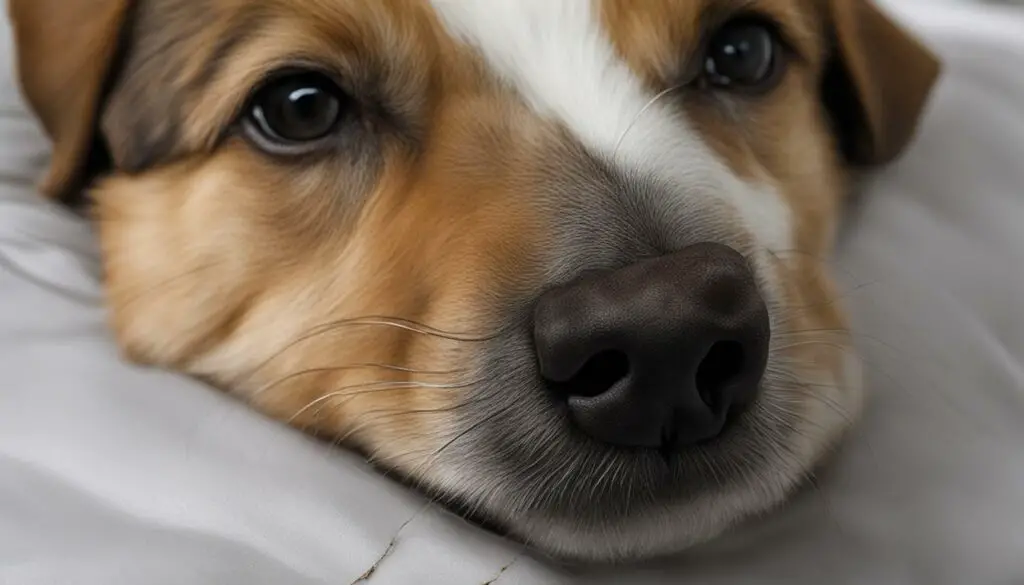
“Proper post-operative care is essential for the healing of the surgical site and the overall well-being of your dog.”
How Should I Care for My Dog After Surgery?
After your dog’s surgery, it is crucial to provide proper care and monitoring to ensure their recovery goes smoothly. Here are some essential post-operative care instructions to follow:
- Keep your dog confined: Restrict your dog’s movement and activity level, allowing them only short trips outside for toilet breaks. This will help prevent any excessive strain or injury to the surgical site.
- Monitor for complications: Watch out for any signs of complications such as repeated vomiting, diarrhea, bleeding or discharge from the wound, extreme lethargy, restlessness, or indications of pain. If you notice any changes in your dog’s behavior or condition, contact your veterinarian immediately for advice.
- Administer medications as prescribed: Make sure to properly administer any medications prescribed by your veterinarian. Follow the dosage instructions and complete the full course of medication to promote healing and prevent infection.
- Maintain wound care: If your dog has stitches or a wound, follow your veterinarian’s guidance on wound care. Keep the area clean and dry, and avoid allowing your dog to lick or chew at the wound. If necessary, use an Elizabethan collar to prevent your dog from accessing the surgical site.
Remember, every dog’s recovery process may vary, so it’s important to closely follow your veterinarian’s specific instructions for post-operative care. By providing the necessary care and attention, you can help ensure your dog’s successful recovery from surgery.
Table: Post-Operative Care Instructions
| Post-Operative Care Instructions |
|---|
| Keep your dog confined to prevent excessive activity and strain on the surgical site. |
| Monitor for any signs of complications such as vomiting, diarrhea, bleeding, or changes in behavior. |
| Administer medications as prescribed by your veterinarian. |
| Follow wound care instructions to keep the area clean and prevent infection. |
| Avoid allowing your dog to lick or chew at the wound. |
By adhering to these care instructions and closely monitoring your dog’s recovery, you can provide the best support and ensure a smooth healing process after their surgery.
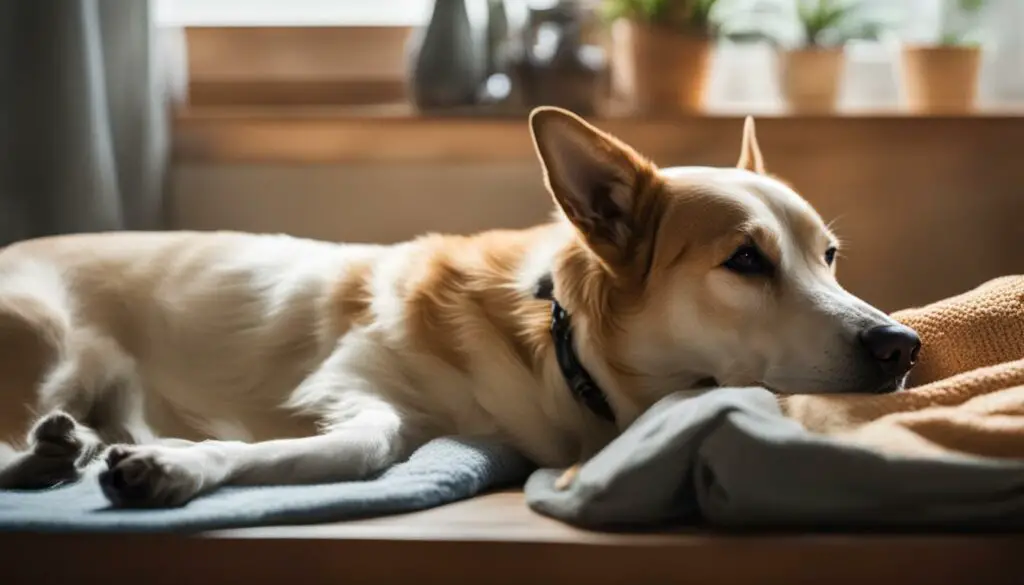
What Are the Possible Risks of Drinking Water Before Surgery?
While it is generally safe for dogs to drink water before surgery, there are some potential risks to be aware of. One of the main concerns is the possibility of vomiting during anesthesia. If a dog has consumed a large amount of water immediately before the procedure, there is an increased chance of them vomiting while under anesthesia. This can be problematic as it may lead to aspiration, where the vomit enters the lungs instead of the stomach, potentially causing pneumonia.
To minimize these risks, it is important to follow the fasting and water intake guidelines provided by your veterinarian. They will advise you on the recommended amount of time your dog should fast before surgery and when to stop giving them water. It’s crucial to adhere to these instructions to ensure a safe and successful surgery for your furry friend.
Additionally, it’s worth noting that excessive water consumption before surgery can also affect the accuracy of certain diagnostic tests. If your dog has an empty stomach, it allows for better monitoring of their vital signs and helps prevent any complications during the procedure. Therefore, it’s crucial to communicate openly with your veterinarian and follow their guidance to minimize any potential risks associated with drinking water before surgery.

Summary:
- Drinking water before surgery can pose minimal risks, but excessive consumption before the procedure may increase the chance of vomiting during anesthesia, potentially leading to aspiration pneumonia.
- Following your veterinarian’s fasting and water intake guidelines is crucial to minimize risks and ensure a safe surgery for your dog.
- An empty stomach before surgery allows for better monitoring of vital signs and more accurate diagnostic tests.
- Communication with your veterinarian is vital to staying informed and ensuring the best possible care for your pet.
The Importance of Following Pre-Anesthesia Instructions
When it comes to the well-being of our beloved pets, following pre-anesthesia instructions is of utmost importance. These instructions are specifically designed to minimize risks and ensure the safety of our furry friends during surgical procedures. Failing to adhere to these instructions, such as providing food or water to our pets before anesthesia, can potentially lead to complications and may even result in the need to delay or reschedule the procedure.
By diligently following the provided pre-anesthesia instructions, we can help facilitate a smooth and successful surgical experience for our pets. These instructions often include guidelines on fasting, which typically involve withholding food for a certain period of time before the procedure. It is crucial to strictly follow these fasting guidelines as they help reduce the risk of complications during anesthesia.
Additionally, it is essential to communicate with our veterinarians and inform them if any accidental deviations occur. Open and honest communication allows the veterinary team to make informed decisions and necessary adjustments to ensure the best possible outcome for our pets. Remember, delaying a procedure due to non-compliance with pre-anesthesia instructions is done to prioritize the safety and well-being of our furry companions.
Ensuring a Safe Anesthetic Event for Your Pet
As a pet owner, the safety and well-being of your furry companion during anesthesia are of utmost importance. Rest assured that your veterinarian takes numerous precautions to ensure a safe anesthetic event for pets. By following established protocols, they aim to minimize risks and provide the best possible care for your pet.
The Role of Pre-Anesthetic Screenings
Before undergoing any procedure requiring anesthesia, your pet will undergo a thorough pre-anesthetic screening. This typically involves a physical examination, blood tests, and sometimes additional diagnostic procedures. These screenings help identify any underlying health conditions that may affect your pet’s response to anesthesia and guide the anesthetic plan accordingly.
Constant Monitoring During Anesthesia
During the procedure, your pet will be closely monitored by trained veterinary professionals. Advanced monitoring equipment allows them to track vital signs such as heart rate, blood pressure, oxygen levels, and respiration. This constant monitoring helps identify any changes in your pet’s condition and allows for immediate intervention if necessary.
Keeping Pets Warm and Pain-Free
Ensuring pets stay warm during surgery is crucial for their comfort and overall well-being. Veterinary hospitals employ techniques such as heated surgical tables, warming blankets, and temperature-controlled environments to maintain optimal body temperature. In addition, veterinarians employ various pain management strategies to keep pets comfortable during and after the procedure.
| Anesthesia Risks | Preventive Measures |
|---|---|
| Anesthetic complications | Thorough pre-anesthetic screenings |
| Cardiovascular issues | Monitoring vital signs throughout the procedure |
| Respiratory problems | Closely monitoring oxygen levels and respiration |
| Allergic reactions | Reviewing your pet’s medical history and using appropriate medications |
While there are potential risks associated with anesthesia, veterinary professionals take every precaution to minimize these risks. By following proper protocols, utilizing advanced monitoring equipment, and tailoring anesthetic plans to each individual pet’s needs, veterinarians strive to provide a safe and successful anesthetic experience for your beloved companion.
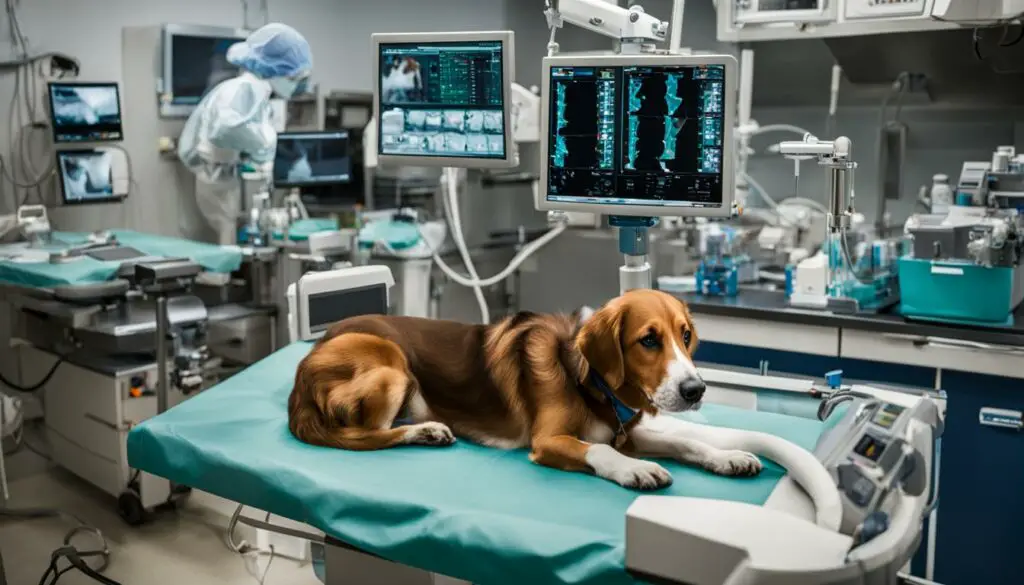
How to Minimize Risks and Concerns Related to Anesthesia
When it comes to anesthesia, ensuring the safety of your pet is of utmost importance. By taking certain precautions and following your veterinarian’s instructions, you can help minimize the risks and concerns associated with anesthesia.
Provide a Detailed Medical History
One key step in minimizing anesthesia risks is to provide your veterinarian with a detailed medical history of your pet. Be sure to inform them about any allergies, previous anesthetic procedures, and current medications your pet is taking. This information will help your veterinarian make informed decisions and tailor the anesthesia protocol to best suit your pet’s needs.
Follow Pre-Anesthesia Fasting Instructions
Following the fasting instructions provided by your veterinarian is crucial in minimizing the risks associated with anesthesia. Fasting your pet for a certain period of time before surgery helps reduce the likelihood of vomiting or regurgitation during the procedure, which can lead to complications. Be sure to strictly adhere to the fasting guidelines given by your veterinarian to ensure a safe anesthesia experience for your pet.
Ensure Proper Monitoring and IV Fluid Therapy
During anesthesia, it is essential to have your pet’s vital signs closely monitored by trained professionals. Blood pressure, heart rate, respiration, and oxygen levels are all important parameters that need to be carefully observed. In addition, having an intravenous (IV) catheter placed and providing your pet with IV fluid therapy throughout the procedure can help maintain hydration and ensure the stability of their vital functions.
By following these steps and maintaining open communication with your veterinarian, you can help minimize risks and ensure the safety of your pet during anesthesia. Remember, your veterinarian is your best resource for guidance and information regarding anesthesia, so don’t hesitate to reach out with any questions or concerns you may have.
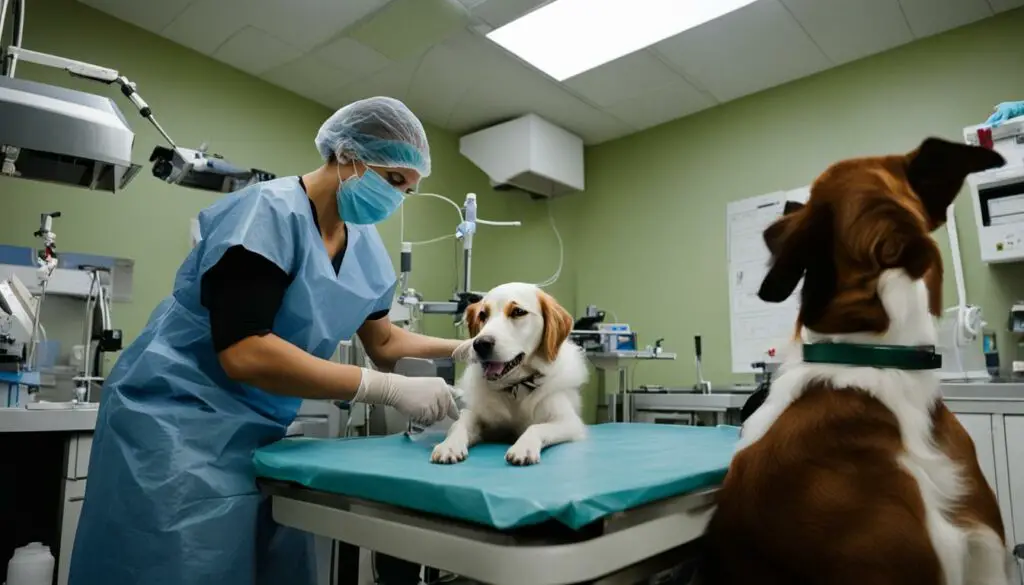
The Role of Anesthetic Monitoring in Ensuring Safety
During surgical procedures, anesthetic monitoring plays a crucial role in ensuring the safety and well-being of pets. Veterinary technicians are trained to closely monitor vital signs such as blood pressure, heart rate, respiration, and oxygen levels to detect any abnormalities or complications that may arise during anesthesia.
Anesthetic monitoring is performed using state-of-the-art equipment and technology, allowing for real-time tracking of these vital parameters. This continuous observation and assessment enable immediate intervention in case of any emergency situations, ensuring that your pet receives prompt medical attention if needed.
Regular monitoring of anesthesia also helps in maintaining the right depth of anesthesia, avoiding over or under-dosing. It allows the veterinary team to adjust the anesthetic regimen as necessary, ensuring a smooth and safe procedure for your pet.
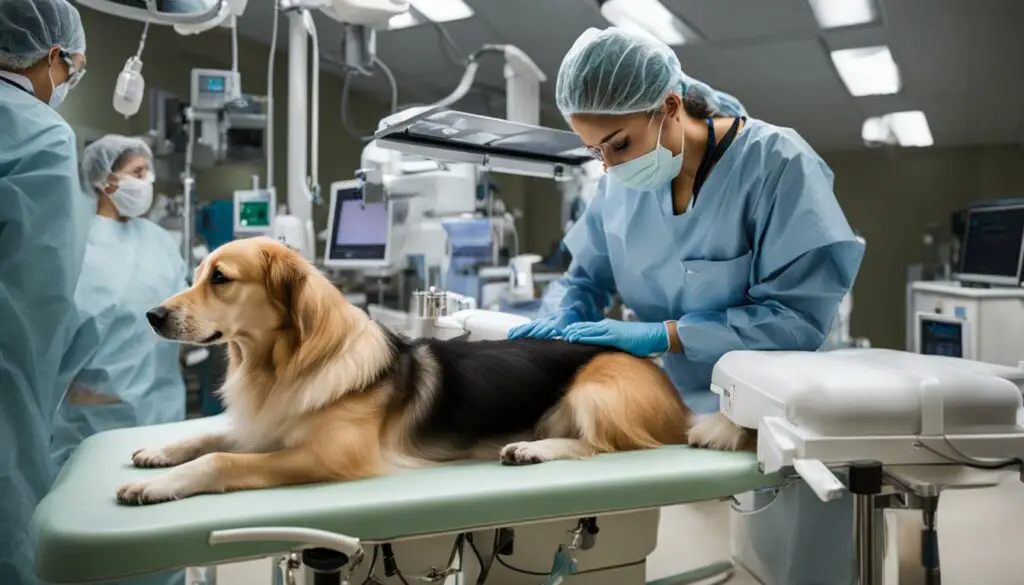
Importance of Anesthetic Monitoring
“Anesthetic monitoring is critical in ensuring the safety of your pet during procedures.”
Anesthetic monitoring is not only performed during the procedure but also throughout the recovery period. After the surgery, pets are closely monitored to ensure smooth recovery from anesthesia and to identify any post-operative complications early on. This comprehensive monitoring helps in managing pain, maintaining vital functions, and taking appropriate measures to minimize any potential risks or discomfort.
By considering the specific needs and characteristics of each individual pet, anesthetic monitoring provides a personalized approach to anesthesia and ensures the highest level of safety and care. With trained professionals and advanced monitoring equipment, your pet’s well-being is prioritized throughout the entire procedure, from induction to recovery.
By understanding the importance of anesthetic monitoring and the dedication of veterinary professionals, pet owners can have peace of mind knowing that their beloved companions are in safe hands during surgical procedures.
The Importance of Post-Anesthesia Recovery and Home Care
After undergoing surgery, proper post-anesthesia recovery and home care are crucial for your pet’s healing and overall well-being. Following specific care instructions provided by your veterinarian is essential to ensure a smooth recovery process. Here are some key aspects to consider:
Schedule and administer medications:
Ensure that you follow the prescribed medication regimen as instructed by your veterinarian. This may include oral medications, topical ointments, or pain relievers. Administer the medications at the recommended intervals to help manage your pet’s pain and prevent any post-operative complications.
Take care of the wound:
Observe the wound carefully and follow any wound care instructions provided by your veterinarian. This may involve cleaning the incision site, applying prescribed ointments or dressings, and preventing your pet from licking or scratching the area. Keeping the wound clean and protected will aid in proper healing.
Monitor for signs of complications:
Watch your pet closely for any unusual symptoms or signs of complications. This may include excessive swelling, discharge from the wound, increased pain, loss of appetite, or changes in behavior. If you notice any concerning signs, contact your veterinarian immediately for further guidance.
Provide a calm and quiet environment:
Ensure that your pet has a quiet and comfortable space for rest and recovery. Minimize noise, stress, and physical activity to promote a calm environment. It is also important to prevent interactions with other pets or young children that may disrupt the healing process.
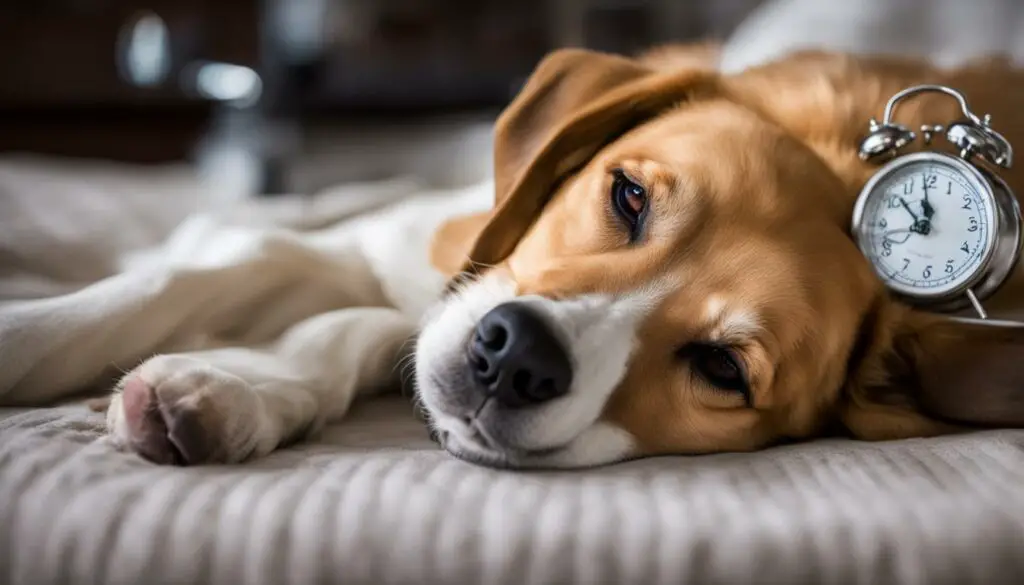
By providing proper post-anesthesia recovery and home care, you can support your pet’s healing process and enhance their overall well-being. Following your veterinarian’s instructions, administering medications, taking care of the wound, monitoring for complications, and providing a calm environment are crucial steps in ensuring your pet’s successful recovery after surgery.
Conclusion
Overall, it is generally safe for dogs to drink water before surgery. However, it is important to follow the pre-surgery instructions provided by your veterinarian to ensure the best outcome for your pet. While water consumption is usually allowed up until the time you leave for the surgery, it is crucial to withhold food after a certain time the night before the procedure to minimize the risk of vomiting while under anesthesia.
After the surgery, caring for your dog’s post-operative needs is essential. Keep a close eye on their condition and the wound, and promptly report any concerning symptoms or signs of complications to your veterinarian. Follow the prescribed medication and wound care instructions, and provide a calm and quiet environment for their recovery.
Remember, it is important to trust your veterinarian’s expertise and recommendations. They take numerous precautions to ensure a safe anesthetic event and provide the best possible care for your pet. By following their instructions and maintaining open communication, you can help minimize risks and ensure the safety and well-being of your furry friend during and after surgery.
FAQ
What if my dog accidentally drank water before surgery?
If your dog accidentally drinks water before surgery, there is usually no cause for concern. Most veterinary hospitals recommend allowing your dog to drink water up until the time you leave for surgery. However, it is important to avoid feeding your dog after 10pm the night before the procedure to reduce the risk of vomiting while under anesthesia.
Can my dog drink water before surgery?
Yes, it is generally safe for your dog to drink water before surgery. Providing water to your dog up until the time you leave for the veterinary hospital can help keep them hydrated. However, it is important to follow the specific instructions provided by your veterinarian regarding fasting and water consumption before surgery.
What are the pre-surgery instructions for dogs?
The pre-surgery instructions for dogs may vary depending on the specific procedure and veterinary hospital. In general, it is recommended to withhold food after a certain time the night before surgery, usually around 10pm. However, water consumption is typically allowed up until the time you leave for the surgery. Always follow the instructions given by your veterinarian to ensure the best outcome for your dog.
Will my dog have stitches after surgery?
Whether or not your dog will have stitches after surgery depends on the type of procedure being performed. In most cases where a skin incision is made, your dog will have either dissolvable sutures that disappear naturally or skin stitches that need to be removed by your veterinarian after a specific period, usually around two weeks. Your veterinarian will provide you with detailed instructions on how to care for the wound and prevent your dog from disturbing the stitches.
How should I care for my dog after surgery?
After your dog’s surgery, it is important to closely monitor their condition and the wound. Keep your dog confined and only let them out for short toilet breaks, and keep cats strictly indoors. Look out for any signs of complications, such as repeated vomiting, diarrhea, bleeding or discharge from the wound, extreme lethargy, restlessness, or signs of pain. Report any changes to your veterinarian immediately and follow any post-operative care instructions provided.
What are the possible risks of drinking water before surgery?
Drinking water before surgery generally poses minimal risks. However, excessive water consumption immediately before the procedure could increase the chance of vomiting while under anesthesia. Vomiting during anesthesia can be problematic as it could lead to aspiration, where the vomit enters the lungs instead of the stomach, potentially causing pneumonia. To reduce these risks, it is important to follow the fasting and water intake guidelines provided by your veterinarian.
What is the importance of following pre-anesthesia instructions?
It is crucial to follow pre-anesthesia instructions provided by your veterinarian to ensure the safety and well-being of your pet. These instructions are designed to minimize risks and complications during and after the procedure. Failure to follow these instructions, such as providing food or water to your pet before anesthesia, can potentially compromise the effectiveness of the procedure and pose unnecessary risks. Always communicate with your veterinarian and inform them if any accidental deviations occur.
How can I ensure a safe anesthetic event for my pet?
As a pet owner, it is natural to have concerns about anesthesia. However, veterinarians take numerous precautions to ensure a safe anesthetic event for pets. These precautions include pre-anesthetic screenings, close monitoring during the procedure, keeping pets warm and pain-free, and following anesthesia protocols tailored to each individual pet. It is important to trust your veterinarian’s expertise and follow their instructions to maximize the safety and well-being of your pet during anesthesia.
How can I minimize risks and concerns related to anesthesia?
To minimize risks and concerns related to anesthesia, it is important to provide your veterinarian with a detailed medical history of your pet, including any allergies, previous anesthetic procedures, and current medications. Your pet should undergo a thorough physical examination before the procedure to assess vital signs and identify any abnormalities. Follow your veterinarian’s pre-anesthesia feeding instructions, which usually involve fasting your pet for a certain period of time before surgery. Additionally, your pet should have an intravenous (IV) catheter placed and receive IV fluid therapy throughout the procedure.
What is the role of anesthetic monitoring in ensuring safety?
Anesthetic monitoring is critical in ensuring the safety of your pet during procedures. Veterinary technicians are trained to monitor vital signs such as blood pressure, heart rate, respiration, and oxygen levels. State-of-the-art equipment is used to closely observe and track these parameters during anesthesia. Trained professionals will monitor your pet’s anesthesia and respond to any emergency situations that may arise.
Why is post-anesthesia recovery and home care important?
Proper post-anesthesia recovery and home care are essential for your pet’s healing and overall well-being. Follow any specific care instructions provided by your veterinarian, including medication administration, wound care, and dietary restrictions. Monitor your pet for any unusual symptoms or signs of complications and promptly report them to your veterinarian. Provide a calm and quiet environment for your pet’s recovery and follow-up with any scheduled post-operative checks.
Source Links
- https://vetsonparker.com.au/can-dogs-drink-water-before-surgery/
- https://www.vetstreet.com/dr-marty-becker/why-your-vet-says-no-food-before-surgery
- https://vcahospitals.com/northwest-veterinary-specialists/-/media/2b85ec8064d7492885d34bc53325aea9.ashx








